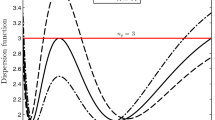Abstract
An optimal experimental design combines high-quality parameter estimation with efficient use of resources. This paper proposes a new method for heuristic optimization of experimental designs in the presence of variable sampling costs. The method finds the inexpensive designs with desirable statistical qualities and provides substantial insight regarding the relative importance (in monetary terms) of sampling at specific design points. The method is illustrated within the context of a start-stop exposure study in aquatic toxicology. Fast heuristics enable the analyses of a large range of sensitivity issues and examination of trade-offs between information and cost. The method is described for designs in which replicate sampling is prohibited; a generalization allowing for replicate sampling is provided as an appendix in the online supplemental materials.
Similar content being viewed by others
References
Atkinson, A. C., and Donev, A. N. (1992), Optimum Experimental Designs, Oxford: Oxford University Press.
Atkinson, A. C., Donev, A. N., and Tobias, R. D. (2007), Optimum Experimental Designs, With SAS, Oxford: Oxford University Press.
Bretthauer, K. M., and Shetty, B. (2002), “The Nonlinear Knapsack Problem—Algorithms and Applications,” European Journal of Operations Research, 138, 459–472.
Cho, E., Bailer, A. J., and Oris, J. T. (2003), “MTBE Effects on the Toxicity of PAH Exposure,” Environmental Science and Technology, 37, 1306–1310.
Cook, D., and Fedorov, V. V. (1995), “Constrained Optimization of Experimental Design” (With Discussion and a Rejoinder by the Authors), Statistics, 26, 129–178.
Cook, R. D., and Nachtsheim, C. J. (1980), “A Comparison of Algorithms for Constructing Exact D-Optimal Design,” Technometrics, 22, 315–324.
Cook, W. J., Cunningham, W. H., Pulleyblank, W. R., and Schrijver, A. (1998), Combinatorial Optimization, New York: Wiley.
Dykstra, O. (1971), “The Augmentation of Experimental Data to Maximize |X′X|,” Technometrics, 13, 682–688.
Elfving, G. (1952), “Optimum Allocation in Linear Regression Theory,” Annals of Mathematical Statistics, 23, 255–262.
Fedorov, V. V., and Hackl, P. (1997), Model-Oriented Design of Experiments, Lecture Notes in Statistics, Vol. 125, New York: Springer.
Fedorov, V. V., and Leonov, S. L. (2005), “Response-Driven Designs in Drug Development,” in Applied Optimal Designs, eds. M. Berger and W.-K. Wong, New York: Wiley.
Fedorov, V. V., Gagnon, R. C., and Leonov, S. L. (2002), “Design of Experiments With Unknown Parameters in the Variance,” Applied Stochastic Models in Business and Industry, 18, 207–218.
Herrendörfer, G. (1977), “The Design and Analysis of Experiments With Grouped Measurements. I. Estimation of Mean,” Biometrical Journal, 19, 107–115.
Kreher, D. L., and Stinson, D. R. (1999), Combinatorial Algorithms: Generation, Enumeration, and Search, Boca Raton, FL: CRC Press.
MATLAB (2008), Version 7.6, Natick, MA: The MathWorks Inc.
Meleško, V. I., and Dol’berg, O. M. (1976), “Compromise Statistical Design of Experiments According to Several Criteria,” Automatic Control and Computer Sciences, 10, 31–36.
Nemhauser, G. L., and Wolsey, L. A. (1988), Integer and Combinatorial Optimization, New York: Wiley.
Sait, S. M., and Youssef, H. (1999), Iterative Computer Algorithms with Applications in Engineering: Solving Combinatorial Optimization Problems, Los Alamitos, CA: IEEE Computer Society.
SAS (1999), SAS/IML User’s Guide Version 8, Cary, NC: SAS.
Seber, G. A. F., and Wild, C. J. (1989), Nonlinear Regression, New York: Wiley.
Tuchscherer, A. (1983), “Experimental Design for Bayesian Estimations in the Linear Regression Model Taking Costs Into Account,” Biometrical Journal, 25, 515–525.
Wright, S. E., and Bailer, A. J. (2006), “Optimal Experimental Design for a Nonlinear Response in Environmental Toxicology,” Biometrics, 62, 886–892.
Author information
Authors and Affiliations
Corresponding author
Additional information
B.M. Sigal participated in this research as a Master’s degree student in the Department of Mathematics and Statistics, Miami University, Oxford, OH.
Rights and permissions
About this article
Cite this article
Wright, S.E., Sigal, B.M. & Bailer, A.J. Workweek Optimization of Experimental Designs: Exact Designs for Variable Sampling Costs. JABES 15, 491–509 (2010). https://doi.org/10.1007/s13253-010-0037-3
Accepted:
Published:
Issue Date:
DOI: https://doi.org/10.1007/s13253-010-0037-3




